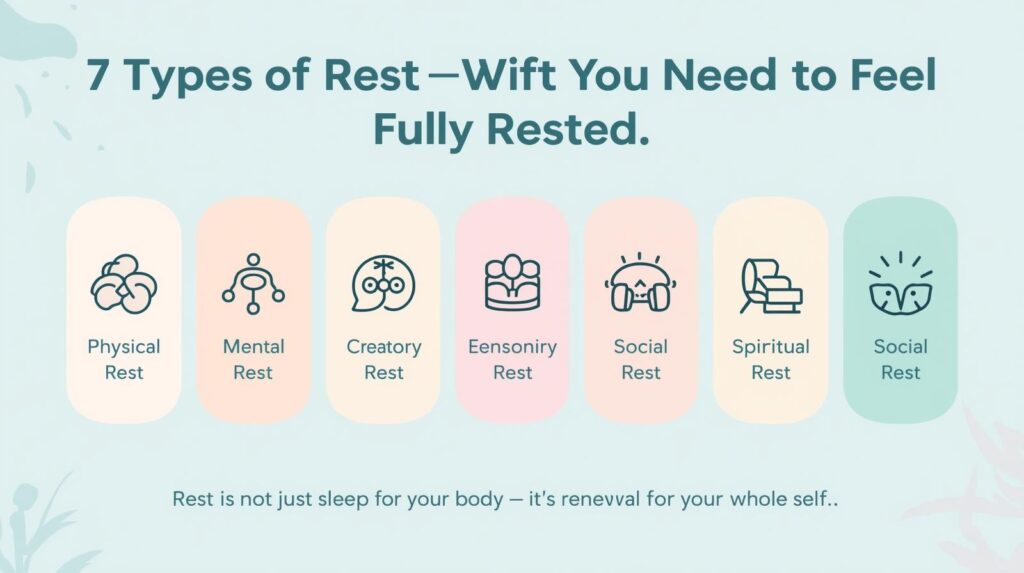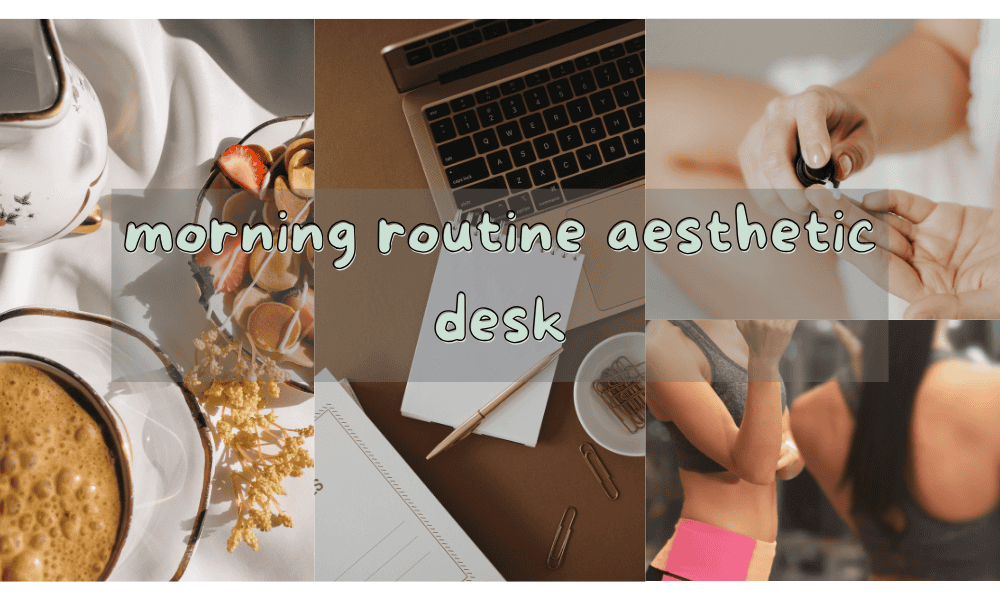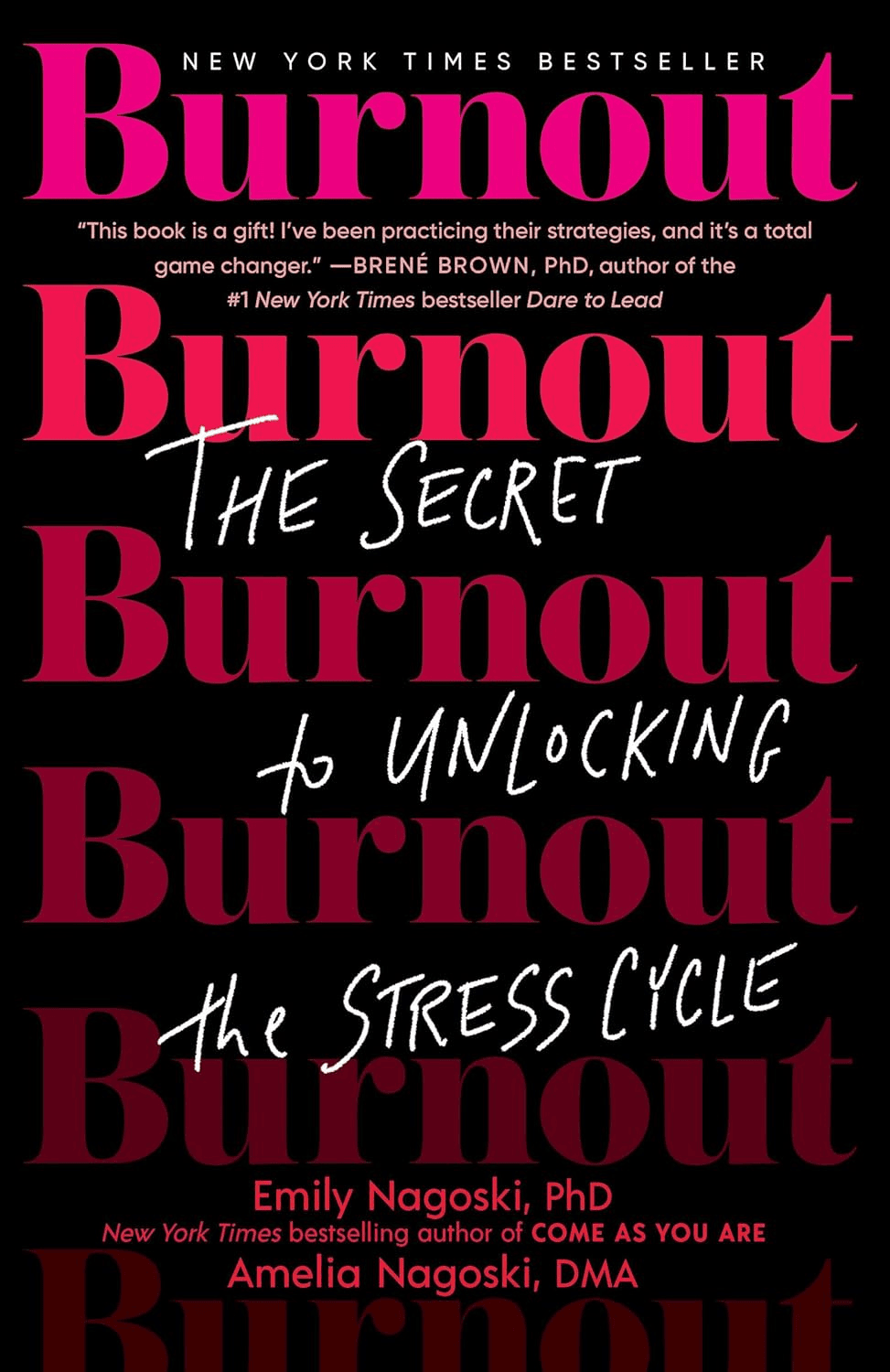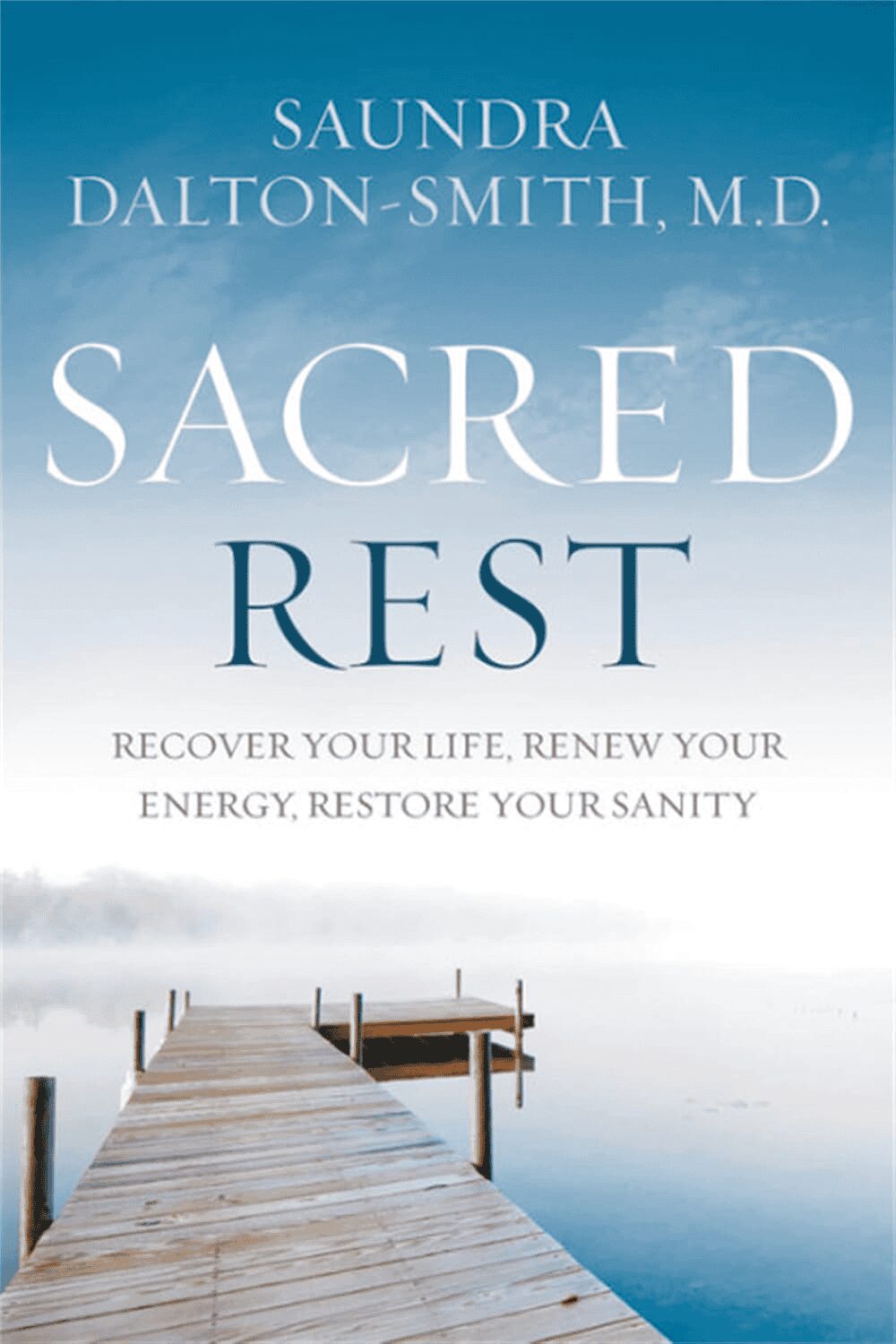Mark slept a solid eight hours but spent his day in a mental fog, snapping at his partner and staring blankly at a project he once loved. Sarah enjoyed a fun weekend with friends, yet felt profoundly lonely and disconnected by Sunday night. Sound familiar? The 7 types of rest show us what our bodies and minds truly need to feel restored.
You might assume the solution is more sleep. Another early bedtime. A weekend spent doing nothing. But what if the problem isn’t how much you’re sleeping—it’s what kind of rest you are actually getting?
Sleep is essential, but it’s only one piece of the puzzle. According to Dr. Saundra Dalton-Smith, a physician and author of Sacred Rest, many people suffer from a rest deficit that has nothing to do with how many hours they spend in bed.
In my medical practice, I found that many patients who complained of fatigue were getting adequate sleep, says Dr. Dalton-Smith. They were suffering from a rest deficit, but it wasn’t a physical one.
This concept, which Dr. Dalton-Smith explored in her widely viewed TED Talk, has helped millions understand why they still feel exhausted despite following all the right sleep hygiene rules. The truth is, there are seven distinct types of rest, and most of us are only addressing one or two.
In this article, you’ll discover the origin of the 7 types of rest framework, take a quiz to identify your personal rest deficit, and get access to a free downloadable worksheet to build your custom rest plan. You’ll also find real-world examples and science-backed strategies to finally beat burnout.
The Science of Rest: It’s Not Just Sleep
Let’s start by clarifying an important distinction: sleep and rest are not the same thing.
Sleep is a biological necessity. Your body uses it to repair tissues, consolidate memories, and regulate hormones. Without it, you can’t function. But rest is broader. Rest is an active state of renewal that addresses your whole person—mind, body, emotions, creativity, and spirit.
Think of sleep as hitting the save button on your body’s operating system. Rest, on the other hand, is more like closing unnecessary tabs, clearing your cache, and running a full diagnostic. Both are essential, but they serve different purposes.
Dr. Dalton-Smith’s research identified that people experience fatigue in seven distinct ways. Each type of exhaustion requires a specific kind of rest to recover. When you don’t get the right type of rest, you end up with what she calls a rest deficit, a chronic state of depletion that sleep alone can’t fix.
This framework has resonated so deeply because it explains something many of us have felt but couldn’t name: the reason you can feel tired even after a full night’s sleep, or why a vacation sometimes leaves you feeling worse than before you left.
Find Your Missing Peace: A 60-Second Self-Scan
Stop guessing what you need. Before we dive in, pause and ask yourself: “Where does my exhaustion live?”
- Is it behind your eyes? → Mental Rest
- In your people-pleasing smile? → Emotional Rest
- In your stagnant creativity? → Creative Rest
- In your heavy limbs? → Physical Rest
Your most honest answer points to your primary rest deficit. Now, read on with purpose.
The 7 Types of Rest: A Deeper Dive

Now let’s explore each type of rest in detail. For each one, you’ll find clear signs that you need it, a unique real-world example, and actionable steps you can take starting today.
1. Physical Rest
You Might Need This If: You recognize the tell-tale signs of a body under strain: waking up feeling stiff or sore despite a full night’s sleep, a constant tightness in your neck and shoulders that follows you through the day, or a reliance on caffeine just to maintain a basic energy level.
Actionable Steps: Moving beyond passive rest like sleep, you can incorporate active recovery into your routine. Consider scheduling a brief, 20-minute nap during your lunch break twice a week to combat the afternoon slump. Weave gentle stretching or foam rolling into your morning ritual to awaken your muscles gently. For deeper tension, prioritize booking a professional massage once a month; this isn’t an indulgence but a strategic intervention to release deep-seated muscle stress.
2. Mental Rest
You Might Need This If: You struggle to concentrate on single tasks, find yourself frequently forgetting small details, or lie awake at night with a mind that races through worries and to-do lists, utterly refusing to turn off.
Actionable Steps: The path to mental rest involves creating deliberate buffers against cognitive overload. Start by keeping a notepad by your bed for a nightly brain dump, transferring all racing thoughts onto paper to clear your mental cache. During work, schedule short, mandatory breaks every 90 minutes to stand up, stare into the distance, and reset your focus. Most importantly, establish a firm mental shutdown time each evening—say, 8 PM—after which you consciously stop making significant decisions or solving complex problems, signaling to your brain that the workday is truly over.
3. Sensory Rest
You Might Need This If: Your senses feel perpetually assaulted, leaving you with strained, dry eyes by midday, a heightened sensitivity to bright lights or loud noises, and a general feeling of being frazzled or overstimulated in busy environments like open offices or crowded stores.
Actionable Steps: To combat sensory overload, begin by creating a sensory sanctuary in your home—a dedicated corner with dim lighting, soft textures, and silence where you can spend just 15 minutes a day without your phone. For ongoing protection, adopt tools like blue light-blocking glasses for evening screen use and invest in a quality pair of noise-canceling headphones to create pockets of auditory peace during deep work sessions. Even the simple act of closing your eyes for five minutes at your desk can offer your visual system a crucial reset.
4. Creative Rest
You Might Need This If: You face the dreaded blank page or screen with a sense of emptiness, find that work which once sparked excitement now feels like a tedious grind, and feel a general disconnection from beauty and inspiration in your daily life.
Actionable Steps: Creative rest is about filling your well of inspiration rather than drawing from it. Make a monthly pilgrimage to a place of beauty, such as a museum, art gallery, or botanical garden, with the sole intention of absorbing the creativity of others. Practice Awe Walking in nature by consciously seeking out things that evoke wonder—the intricate pattern of frost on a window, the vastness of a city skyline. Finally, curate your workspace to be a source of inspiration, surrounding yourself with images, art, or objects that visually remind you of what you find beautiful and meaningful.
5. Emotional Rest
You Might Need This If: You frequently find the word yes leaving your lips when your entire being is screaming no, you feel compelled to hide your true feelings to maintain harmony, and you have the persistent sense that you are performing a role—the agreeable employee, the easy-going friend—rather than living as your authentic self.
Actionable Steps: Achieving emotional rest requires cultivating spaces where you can be real. Start by scheduling a weekly feelings audit, a dedicated 10 minutes with a timer where you speak to a trusted confidant or journal with raw honesty about your emotions, without any filter. Actively identify the relationships in your life where you feel most seen and valued, and intentionally schedule more one-on-one time with those people. Crucially, permit yourself to practice saying no to one small request each week that doesn’t align with your true priorities or energy levels.
6. Social Rest
You Might Need This If: Your social interactions leave you feeling more drained than replenished, you notice yourself overextending to maintain relationships that feel one-sided or unfulfilling, and you find yourself craving solitude more often than connection.
Actionable Steps: The key to social rest is strategic connection. Begin by creating a relationship energy map: list the people you interact with regularly and note whether each relationship is typically energizing, neutral, or draining. Use this map to consciously rebalance your social calendar, dedicating more time to those who fill your cup and setting firmer boundaries with those who deplete it. This might look like scheduling regular, quality time with a truly supportive friend while also giving yourself full permission to decline social invitations when you need solitude to recharge.
7. Spiritual Rest
You Might Need This If: A quiet question of what this is all for? echoes in your mind, you feel a sense that something is missing even when your life looks “fine” on paper, and you experience a deep longing for a sense of belonging, purpose, or contribution to something larger than yourself.
Actionable Steps: Spiritual rest is found through reconnection to meaning. Dedicate time to reflect on your core, non-negotiable values and then identify one practical way you can live them out more fully in the coming week. Seek out a community—whether based on faith, philosophy, or a shared cause—that aligns with your sense of purpose, as belonging is a powerful antidote to spiritual fatigue. Even small, consistent practices like meditation, mindful walking in nature, or keeping a gratitude journal can cultivate the inner stillness needed to feel grounded and connected once more.
Your Personal Rest Plan: Building a Sustainable Routine

Now that you understand the 7 types of rest, it’s time to build your custom plan.
Now that you understand the 7 types of rest, it’s time to put them into action.
Take a few minutes to design your own rest strategy , one that fits your lifestyle and energy needs.
- A checklist to audit your current rest levels across all seven types
- A weekly planner to schedule specific rest activities based on your deficit areas
- Reflection prompts to help you track your progress and adjust as needed
Knowledge is power, but a plan is progress. Don’t just read about rest, actually do something about it.
Overcoming the I Don’t Have Time Objection
One of the biggest obstacles to rest is the belief that you’re too busy for it. But rest doesn’t require hours of free time. In fact, rest micro-habits—small, intentional moments of rest woven into your day—can be just as effective as longer breaks.
Here are a few examples:
- Physical rest: Stretch for two minutes between meetings
- Mental rest: Close your eyes and take five deep breaths before starting a new task
- Sensory rest: Step outside for 60 seconds to feel the sun on your face
- Creative rest: Keep a photo of a place you love on your desk and look at it when you feel stuck
- Emotional rest: Text a friend and say exactly how you’re feeling (without sugarcoating)
- Social rest: Take your lunch break alone with a book instead of in the office break room
- Spiritual rest: Write down one thing you’re grateful for before bed
Rest doesn’t have to be elaborate. It just has to be intentional.
Further Reading for a Rested Life
If you want to dive deeper into the science and practice of rest, here are a few essential books:
- Sacred Rest by Dr. Saundra Dalton-Smith – The foundational text on the 7 types of rest. This book will change the way you think about exhaustion and recovery.
- Burnout: The Secret to Unlocking the Stress Cycle by Emily and Amelia Nagoski – A powerful guide to understanding and completing the body’s stress cycle, especially valuable for emotional and physical rest.
- Rest: Why You Get More Done When You Work Less by Alex Soojung-Kim Pang – Explores the science of deliberate rest and why top performers prioritize recovery as much as effort.
These books complement each other beautifully and provide a well-rounded approach to building a more rested, resilient life.
Rest Is Your Right, Not a Reward
For too long, we have treated rest as something we have to earn. A reward for working hard enough. A luxury reserved for weekends and vacations.
But rest is not a bonus—it’s a requirement. Without it, you can’t sustain creativity, productivity, or joy. Without it, you’re just running on fumes, wondering why you feel so empty despite doing everything right.
By understanding the 7 types of rest, you’re not just fighting burnout. You’re reclaiming your energy, your creativity, and your sense of self. You’re permitting yourself to be human in a world that constantly demands you be superhuman.
Start with one type of rest. Take the quiz. Download the worksheet. Build your plan. Your future, well-rested self thanks you.



